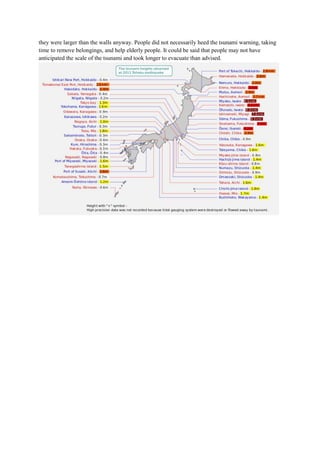Tohoku earthquake case study
- 1. Case study: Tohoku Earthquake 2010 Where did it happen? Japan is located on the Pacific ring of fire, at the destructive boundary between the Pacific plate, the Eurasian plate and the Philippine plate. Tohoku is the region of the northeastern Honshu, the largest island of Japan. When did it happen?At 2:46pm on the 11th March 2011 a magnitude 9.0 mega thrust earthquake struck 72km east of the Oshika peninsula. It had a shallow focus, 32km and released the equivalent of 9,320 gigatons of TNT. The shaking lasted for 6 minutes. The 6-8m of up-thrust of land from the earthquake triggered a tsunami where the waves were, in places, 8-10m Primary effects E c o n o m i c S o c i a l E n Panic caused by the massive earthquake. Fewer than 20 people were killed by the earthquake. Liquifaction covered large areas in mud. Secondary effects The cost of recovery cost $235 billion. The yen fell sharply but recouped most of its decline several hours later. Tokyo stocks fell. Economic loss from the nuclear meltdown 15,883 deaths, 6,150 injured, 2,651 people missing as a result of the tsunami. 92.5% of these people died by drowning. 45,700 buildings were destroyed and 144,300 were damaged by the quake and tsunami. 1.2 million homes without power 1.4 million homes without water 582 roads cut off 32 bridges destroyed The earthquake and tsunami created an estimated 24–25 million tons of rubble and debris in Japan An estimated 230,000 automobiles and trucks were damaged or destroyed in the disaster At Fukushima the tsunami disabled emergency generators required to cool the reactors triggering a nuclear meltdown. People were evacuated from their homes. Approximately 531,000 nonJapanese residing in Japan departed the country after the quake and tsunami, including approximately 25% of foreigners living in Tokyo The earthquake triggered a tsunami the had waves as high as 10m
- 2. v i r o n m e n t a l Ground ruptured. Immediate responses Three minutes after the quake a tsunami warning was issued. Meteorological Agency official appeared on TV urging those affected by the quake not to return home because of possible tsunamis. Fifty-nine search and rescue experts, four medics and two sniffer dogs flew out on a private charter plane with 11 tonnes of equipment on board. Strong police presence 91 countries have offered aid, from blankets and food to search dogs and military transport. Many animals would have been killed by the tsunami. Long term responses According to Japan's foreign ministry, 116 countries and 28 international organizations offered assistance. Japan specifically requested assistance from teams from Australia, New Zealand, South Korea, and the United States. Jackie Chan donated $3 million. How was the hazard managed?The p-waves from the earthquake were detected and a warning was sent to televisions and mobile phones seconds before the earthquake struck. This gave the Japanese time to execute will practiced earthquake drills, such as taking shelter under tables. A warning for the tsunami was given 3 minutes after the earthquake giving people approximately 20 minutes the evacute. Why did the tsunami had such a damaging effect despite the warnings and sea walls?In places the land subsided by 1-2 m meaning that the sea walls were not as high as they were thought to be. This meant the tsunami easily swept over the walls. Also, in some places the waves were so large that
- 3. they were larger than the walls anyway. People did not necessarily heed the tsunami warning, taking time to remove belongings, and help elderly people. It could be said that people may not have anticipated the scale of the tsunami and took longer to evacuate than advised.


